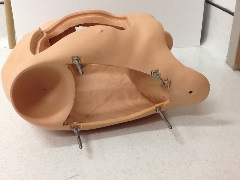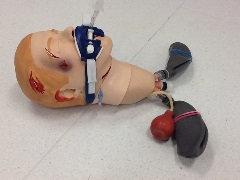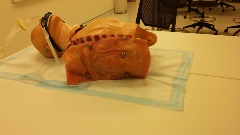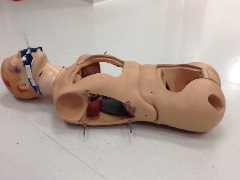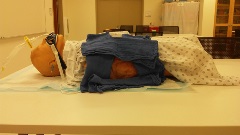HomeGrown Solution: Design and Evaluation of a More Realistic Tube Thoracostomy Task Trainer (T-4)
Title
Submitted By
HomeGrown Solution Number
Identification of the Problem
Unique Idea
Objectives
Supplies/Ingredients
- Spare hollowed out manikin chest
- Spare simulator head
- 8- 4 inch long rods
- 8 - bolts
- 8 - wing nuts
- 1 Ventilator
- 2 racks of pork ribs
- 2 sections of pig skin
- Nebulizer tubing
- BLS lungs cut and sealed to size
Steps to Creating the Solution
- Take the hollowed out spare manikin chest piece and draw out sections to be cut away on each side of the chest.
- Drill out all holes for the pieces of rod. (Note: you must file down end of rod to a point to pierce the skin and ribs during installation).
- Make lungs for the simulator head if it doesn't already have them. To do this, simply take an adult lung from a BLS Anne and heat seal it down the middle. Insert nebulizer tubing into each section and seal with tap. Take the constructed lungs and secure those to the airway of the manikin head.
- Connect manikin head to torso.
- Intubate manikin head using 7.0 ETT tube.
- Connect vent to ETT tube to allow the lungs to inflate and deflate.
- Connect one rack of ribs to each side of the torso.
- Measure out the length of skin needed for each side of the chest and cut pig skin to fit.
- Secure pig skin over the ribs and tighten with wing nuts.
- Place gown over simulator and dress each side of the chest to only expose where the procedure should be done.
Images
Video
HomeGrown Disclaimer
The information contained within this website is for information purposes only. While the website is monitored in an attempt to keep the information up to date and accurate, be aware that there are no representations or warranties of any kind, express or implied, about the completeness, accuracy, reliability, and/or suitability being made. The sponsors of this website are not liable for any loss or damage that may result from using information contained within this website. Any reliance you place on the information contained within this website is strictly at your own risk.
Please note that sections of this website include postings of individuals not associated with the website sponsors. These postings are not endorsed or warrantied by the website, and use of such information is at your own risk.
Always check the user guide/manuals provided by the manufacturer of your manikin or task trainer. Using products that are not sanctioned may invalidate the product warranty. (For example: Some products could stain the skin on a manikin. Liquids used around electrical parts may cause malfunctions.)


